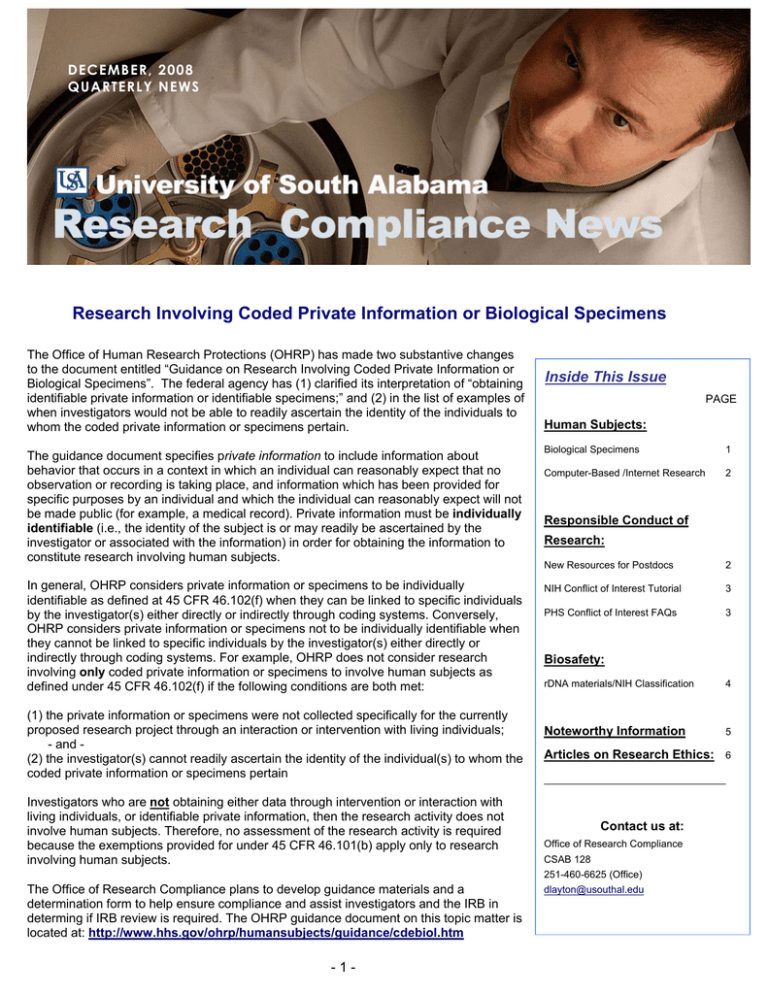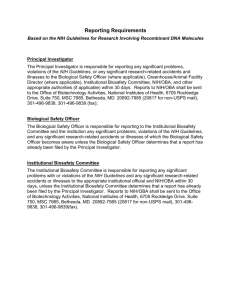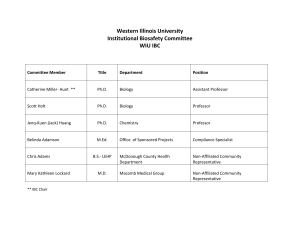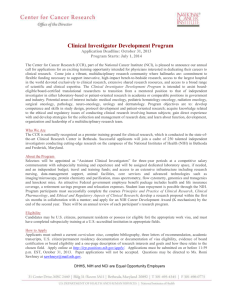Document 11147656
advertisement

DECEMBER, 2008 QUARTERLY NEWS Research Involving Coded Private Information or Biological Specimens The Office of Human Research Protections (OHRP) has made two substantive changes to the document entitled “Guidance on Research Involving Coded Private Information or Biological Specimens”. The federal agency has (1) clarified its interpretation of “obtaining identifiable private information or identifiable specimens;” and (2) in the list of examples of when investigators would not be able to readily ascertain the identity of the individuals to whom the coded private information or specimens pertain. The guidance document specifies private information to include information about behavior that occurs in a context in which an individual can reasonably expect that no observation or recording is taking place, and information which has been provided for specific purposes by an individual and which the individual can reasonably expect will not be made public (for example, a medical record). Private information must be individually identifiable (i.e., the identity of the subject is or may readily be ascertained by the investigator or associated with the information) in order for obtaining the information to constitute research involving human subjects. In general, OHRP considers private information or specimens to be individually identifiable as defined at 45 CFR 46.102(f) when they can be linked to specific individuals by the investigator(s) either directly or indirectly through coding systems. Conversely, OHRP considers private information or specimens not to be individually identifiable when they cannot be linked to specific individuals by the investigator(s) either directly or indirectly through coding systems. For example, OHRP does not consider research involving only coded private information or specimens to involve human subjects as defined under 45 CFR 46.102(f) if the following conditions are both met: (1) the private information or specimens were not collected specifically for the currently proposed research project through an interaction or intervention with living individuals; - and (2) the investigator(s) cannot readily ascertain the identity of the individual(s) to whom the coded private information or specimens pertain Investigators who are not obtaining either data through intervention or interaction with living individuals, or identifiable private information, then the research activity does not involve human subjects. Therefore, no assessment of the research activity is required because the exemptions provided for under 45 CFR 46.101(b) apply only to research involving human subjects. Inside This Issue PAGE Human Subjects: Biological Specimens 1 Computer-Based /Internet Research 2 Responsible Conduct of Research: New Resources for Postdocs 2 NIH Conflict of Interest Tutorial 3 PHS Conflict of Interest FAQs 3 Biosafety: rDNA materials/NIH Classification 4 Noteworthy Information 5 Articles on Research Ethics: 6 Contact us at: Office of Research Compliance CSAB 128 251-460-6625 (Office) The Office of Research Compliance plans to develop guidance materials and a determination form to help ensure compliance and assist investigators and the IRB in determing if IRB review is required. The OHRP guidance document on this topic matter is located at: http://www.hhs.gov/ohrp/humansubjects/guidance/cdebiol.htm -1- dlayton@usouthal.edu SPOTLIGHT on Social Science and Internet Based Human Subjects Research Human subject’s research and data collection via the Internet requires the researcher to still obtain informed consent. This method of data collection for survey researchers provides an opportunity for greater numbers of participants, however has eliminated the process of obtaining traditional informed consent for study participation. Internet communities (such as mailing lists, chat rooms, newsgroups, or discussion boards on websites) are rich sources of qualitative data for researchers. These type of protocols must address potential risks (e.g., violation of privacy, legal risks, and psychosocial stress) and provide the same level of protection as any other types of research involving human participants. Although the majority of survey research is considered minimal risk, the IRB requires that informed consent be acquired before participants can proceed in the research study. An on-line consent document should be written like a cover letter and include all basic elements of a standard signed consent. Key elements of consent for internet-based survey research includes: • Purpose of the research • Risks/benefits • Activities required to participate in research • Confidentiality of responses • Voluntary participation • Contact information for PI and IRB The consent line should note “by completing the survey you are agreeing to participate in research”. Additionally, Internet based research should include “I agree” or “I do not agree” buttons on the webpage so participant is given to choice to participate. Under these circumstances, the investigator must request to the IRB a waiver of signed documentation of informed consent to use these methods. USA’s IRB guidance document on conducting computer and internet-based research involving human subjects is available at: http://www.southalabama.edu/researchcompliance/pdf/netresearchguide.pdf New Resources for Postdoctoral Fellows on Responsible Conduct of Research The National Postdoctoral Association (NPA) sponsors the "Bring RCR Home" project, a national initiative to foster programming on the responsible conduct of research (RCR) for postdoctoral scholars at their "home" research institutions. The College of Medicine was awarded a $1,000 seed grant from the NPA to help fund the implementation of these activities, along with additional support from the Office of the Dean. As a result, the College of Medicine will implement its first Responsible Conduct of Research (RCR) training for postdoctoral fellows beginning in January. The RCR program of instruction is designed to stimulate and foster ethical and professional standards geared towards enhancing trainees’ career development and cultivating a culture of compliance concerning ethical standards and scholarship. The RCR training curriculum is designed as a handson, interactive series of monthly workshops/discussions focusing on six key areas, interweaving discussion related to grants writing and development of an independently funded research career concerning topics as: • • • • • • Grants – resources and career stage Building preliminary data and rationale – how to create your niche Data acquisition and management Collaborations and team science Mentor-mentee relationships Peer review – unbiased, constructive critique Fellows completing at least five of the six modules will receive a Certificate of Completion. For additional information contact the Program Director, Dr. Mary Townsley at 460-7708 or Program Co-Director, Dusty Layton at 460-6625. -2- NIH Financial Conflict of Interest Tutorial The National Institutes of Health released a web-based tutorial on financial conflict of interest regulations and the requirements for NIH-supported institution and investigators. The tutorial release came after recent criticism by Senator Charles Grassley (R-IA) of the NIH’s laxed enforcement of the FCOI policy, Title 42 CFR Part 50, Subpart F, Responsibility of Applicants for Promoting Objectivity in Research for Which PHS Funding is Sought. Over the past year there has been an increased focus on accurate reporting by researchers of potential financial conflicts of interest that external compensation or equity interest may pose to federally funded research. The tutorial was developed to help enhance compliance and ensure research is conducted without bias. The NIH Guide announcement (NOT-OD-08106) available at: http://grants.nih.gov/grants/guide/noticefiles/NOT-OD-08-106.html provides access to the tutorial and additional information on its release. PHS Policy and Financial Conflict of Interest Regulations……A Posting of Frequently Asked Questions The NIH Office of Extramural Research has compiled answers to the most frequently asked questions regarding the implementation of the federal regulation on Financial Conflict of Interest enforced by the NIH. The FAQs have been categorized into three sections for easy reference to include general questions, institution-specific and investigator-specific questions. One question clarified is “who is considered an “Investigator” for this purpose? An “Investigator” is defined as the Principal Investigator and any other person who is responsible for the design, conduct, or reporting of research funded by the NIH, or proposed for such funding, including subgrantees, contractors, or collaborators. The definition of Investigator includes the Investigator’s spouse and dependent children. Thus, if a post-doctoral fellow meets the definition of an Investigator, he or she would be subject to the regulation. Consult the Office of Research Compliance or the Office of the Vice President to ensure you comply with the appropriate requirements for sponsored projects. The complete listing of FAQs is posted at: http://grants1.nih.gov/grants/policy/coifaq.htm -3- Investigators engaged in federally funded research are reminded that conflict of interest disclosure forms must be updated at any time their outside compensation or equity exceeds the reportable threshold as prescribed in the PHS and NSF policies. The September issue of the Office of Research Integrity's (ORI) newsletter features several interesting articles, including two on conflict of interest issues in research misconduct inquiries and investigations. Of particular interest is an article on page 5 that focuses on ORI's perspective on dealing with COIs. The quarterly ORI newsletter is posted at: http://ori.dhhs.gov/publications/ne wsletters.shtml Recombinant DNA Materials and NIH Classification All research involving Recombinant DNA, including exempt work, is subject to the NIH “Guidelines for Research Involving Recombinant DNA Molecules” and must be registered with the Institutional Biosafety Committee (IBC). The summary of the NIH guidelines and its classification categories can be found on the USA Biosafety website at: http://www.southalabama.edu/researchcompliance/pdf/rdnaguidelinesexp.doc Recombinant DNA experiments involving animal, microbial pathogens, animals, or humans require IBC approval before initiation of the activities regardless of the NIH classification or the source of funding. The NIH defines recombinant DNA molecules as molecules that are constructed outside living cells by joining natural or synthetic DNA segments to DNA molecules that can replicate in a living cell, or molecules that result from the replication of those previously described. Risk group classification is related specifically to the risk associated with a particular material. Biosafety levels are containment requirements designed to mitigate the risk identified in a Risk Assessment that is used to assign a Risk Group to a material. The information outlined is provided to help researchers determine the appropriate risk group and biosafety level containment: Risk Group (NIH Guidelines) RG1: Agents are NOT associated with disease in healthy adult humans Containment Level BSL1: Work is done on open bench top/special containment is not required Standard microbiological practices Biohazard signs to be posted Examples Escherichia coli K12 and it’s derivatives (DH5a, JM109), pBluescript, PYAC4, lambda GT-11 vector RG2: Agents are associated with human disease which is rarely serious. (moderate risk) BSL2: - Adenovirus all types All human blood Human cell lines (ie, HEK 293) Herpes simplex virus Herpes virus saimiri Murine retrovirus-based vectors Retroviral packaging cell lines - - - All BSL-1 containment and practices PLUS: Lab access is restricted when work is in progress Personnel have specific training in handling of agents Biological safety cabinets or other containment devices are used for potential aerosol generation procedures Biohazard signs must be posted to include agent/contact information Specific PPE requirements RG3: Agents are associated with serious or lethal human disease for which preventive or therapeutic interventions MAY be available (high risk) BSL3: - RG4: Agents are likely to cause serious or lethal human disease for which preventive or therapeutic interventions are not usually available. The university currently does not approve any work at BSL-4 level. - All BSL-2 containment and practices plus the following: Specific facility design parameters must be followed, including requirements for location, ventilation, room integrity and security -4- Industrial scale volumes of Lenti viruses or Lentiviral vectors Rickettsia prowazekii NONE – no current usage of this risk group classification at USA Continued from page 4…… Viral Vectors Risk Group/Biosafety Level Adenovirus Risk Group 2: BL2 Murine Retrovirus-Ecotropic/Amphotropic or VSV-G pseudotyped Risk Group 2: BL2 Lentivirus (3rd generation)** Risk Group 3: BL2 AAV (w/adenovirus helper) Risk Group 2: BL2 AAV (helper free) Risk Group 1: BL2 Herpes virus Risk Group 2: BL2 ** Special requirements – needle protective devices should be used for injection procedures when possible, sealed rotor heads and/or canisters should be used for centrifugation and opened only in a biosafety cabinet, use only ultracentrifuges fitted with HEPA filters. For additional questions regarding recombinant DNA materials such as retroviruses, adenoviruses and/or lentiviral vectors, contact the Institutional Biosafety Chair at malexeye@jaguar1.usouthal.edu y y y Noteworthy Information y y y The Office of Research Compliance and Assurance has revised its website. All the necessary resources covering a broad range of research compliance programs and requirements such as the IRB, IACUC, Biosafety, Conflicts of Interest, Export Controls, etc. are posted at: http://www.southalabama.edu/researchcompliance/index.html If you need information you do not find on these pages, please contact Ms. Layton eat 460-6625 or dlayton@usouthal.edu Our primary mission is to serve as a resource to researchers, administrative offices, and regulatory compliance committees for the University research community. * * * * * * * * * * * The Association for Assessment and Accreditation of Laboratory Animal Care (AAALAC) International reviewed the University’s animal care and use program in June, 2008. A team of AAALAC representatives reviewed the University’s Program Description, staff and supporting documentation and a review of animal research facilities. AAALAC awarded the University with continued full accreditation with no noted deficiencies. Accreditation is valid for a period of 3 years. * * * * * * * * * * * The Institutional Review Board (IRB) was inspected by the Food and Drug Administration (FDA) in August, 2008. The purpose of such an inspection is to determine whether the IRB procedures for the protection of human subjects comply with Title 21CFR Parts 50 and 56. These regulations apply to clinical studies of products regulated by the FDA. The on-site review consisted of a three day review of selected IRB approved protocols, policies/procedures, minutes, training and other regulatory documentation. The FDA inspection concluded in its establishment report that the IRB adhered to all applicable statutory requirements with no reportable citations. * * * * * * * * * * * NIH Announces New Transformative R01 Funding Program - The NIH intends to invest more than $250 million over the next five years to foster bold and creative investigator-initiated research through a new transformative R01 (T-R01) Program. While R01 grants support the bulk of mainstream NIH investigator-initiated efforts, the structure and review of R01 proposals can discourage submission of the most bold, creative, and risky research proposals. In response to these challenges, the NIH has created the T-R01 Program. "The T-R01 Program will pilot novel approaches to peer review to facilitate identification and support of the most ground-breaking, high impact research and augment the existing Pioneer and New Innovator Awards programs," said NIH Director Elias A. Zerhouni, M.D. - September 9, 2008. More detailed information is at: http://www.nih.gov/news/health/sep2008/od-09a.htm -5- Articles on Research Ethics / Links of Interest o “Mentoring and Research Misconduct: An Analysis of Research Mentoring in Closed ORI Cases”, Science and Engineering Ethics, 14, 323-336, 2008. (Noted trainee misconduct accounts for one third of the Office of Research Integrity findings. Almost three quarters of the mentors had not reviewed the source data of the trainee and two thirds had not set research standards). o NIH Halts Study at Emory Over Concerns About Drug Company's Payments, The Chronicle of Higher Education News Blog, October 14, 2008 http://chronicle.com/news/article/5331/nih-halts-study-at-emoryover-concerns-about-drug-companys-payments (The National Institutes of Health has halted a $9.3-million five-year research project at Emory University, pending an investigation into potential conflicts of interest by the project’s former leader) o Whose Blood Is It?, Inside Higher Ed, Dec 1, 2008 "…a decision Friday by an Arizona appeals court to revive a lawsuit by a small Indian tribe against the Arizona Board of Regents and some researchers involved in the use of blood collected from the tribe. Tribe members consented to the blood being used for research on why they may have been experiencing high rates of diabetes…Some of the additional research challenged the tribe’s religious beliefs and members say they never would have contributed to such studies…" o Anesthesia and Other Considerations for in Vivo Imaging of Small Animals. Isabel J. Hildebrandt, Helen Su, and Wolfgang A. Weber. ILAR Journal. Volume 49(1), 2008. http://dels.nas.edu/ilar_n/ilarjournal/49_1/html/v4901Hildebrandt.shtml o Ethics Grand Rounds Presentation at the NIH Clinical. Listen to podcasts or view webcasts of past Clinical Grand Rounds lectures at http://videocast.nih.gov/PastEvents.asp?c=27 Newsletter archives are available through the Office of Research Compliance website at: http://www.southalabama.edu/researchcompliance/index.html -6-






